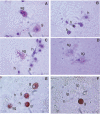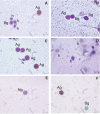First cytochemical study of haemocytes from the crab Carcinus aestuarii (Crustacea, Decapoda)
- PMID: 20353916
- PMCID: PMC3167293
- DOI: 10.4081/ejh.2010.e9
First cytochemical study of haemocytes from the crab Carcinus aestuarii (Crustacea, Decapoda)
Abstract
For the first time, a morphological study of haemocytes from the crab Carcinus aestuarii was carried out by means of light microscopy and differing cytochemical assays. Analysis of haemocyte size frequency distribution (performed by means of a Coulter Counter) revealed the presence of two distinct haemocyte fractions in C. aestuarii haemolymph, depending on cell size. The first fraction was of about 3-5 microm in diameter and 30-50 fL in volume, the second was of about 6-12 microm in diameter and over 200 fL in volume. Mean cell diameter and volume were 8.20+/-1.7 microm and 272.30+/-143.5 fL, respectively. Haemocytes observed under light microscope were distinguished in three cell types: granulocytes (28%; 11.94+/-1.43 microm in diameter) with evident cytoplasmic granules, semigranulocytes (27%; 12.38+/-1.76 microm in diameter) with less granules than granulocytes, and hyalinocytes (44%; 7.88+/-1.6 microm in diameter) without granules. In addition, a peculiar cell type was occasionally found (about 1%): it was 25-30 microm in diameter and had a great vacuole and a peripheral cytoplasm with granules. Granulocyte and semigranulocyte granules stained in vivo with Neutral Red, indicating that they were lysosomes. Giemsa's dye confirmed that granulocytes and semigranulocytes were larger than hyalinocytes. Pappenheim's panoptical staining and Ehrlich's triacid mixture allowed to distinguish granule-containing cells (including semigranulocytes) in acidophils (64%), basophils (35%) and neutrophils (1%). Hyalinocytes showed always a basophilic cytoplasm. Haemocytes were positive to the PAS reaction for carbohydrates, even if cytoplasm carbohydrate distribution varied among cell types. Lastly, lipids were found on cell membrane and in cytoplasm of all haemocyte types in the form of black spots produced after Sudan Black B staining. The morphological characterisation of C. aestuarii haemocytes by light microscopy was necessary before performing both ultrastructural and functional studies of circulating cells.
Figures





Similar articles
-
Haemocytes of the cockle Cerastoderma glaucum: morphological characterisation and involvement in immune responses.Fish Shellfish Immunol. 2007 Oct;23(4):732-46. doi: 10.1016/j.fsi.2007.01.020. Epub 2007 Feb 1. Fish Shellfish Immunol. 2007. PMID: 17368050
-
A first insight into haemocytes of the smooth venus clam Callista chione.Fish Shellfish Immunol. 2015 Feb;42(2):494-502. doi: 10.1016/j.fsi.2014.11.034. Epub 2014 Dec 4. Fish Shellfish Immunol. 2015. PMID: 25481693
-
Pinna nobilis: A big bivalve with big haemocytes?Fish Shellfish Immunol. 2016 Aug;55:529-34. doi: 10.1016/j.fsi.2016.06.039. Epub 2016 Jun 23. Fish Shellfish Immunol. 2016. PMID: 27346153
-
Haemocyte morphology and function in the Akoya pearl oyster, Pinctada imbricata.J Invertebr Pathol. 2010 Sep;105(1):36-48. doi: 10.1016/j.jip.2010.04.011. Epub 2010 May 8. J Invertebr Pathol. 2010. PMID: 20457162
-
Back to the future: Forgotten protocols for optimizing the isolation of arthropod haemocytes.Dev Comp Immunol. 2024 Oct;159:105223. doi: 10.1016/j.dci.2024.105223. Epub 2024 Jul 1. Dev Comp Immunol. 2024. PMID: 38960294 Review.
Cited by
-
A Comprehensive Review on Crustaceans' Immune System With a Focus on Freshwater Crayfish in Relation to Crayfish Plague Disease.Front Immunol. 2021 May 13;12:667787. doi: 10.3389/fimmu.2021.667787. eCollection 2021. Front Immunol. 2021. PMID: 34054837 Free PMC article. Review.
-
On the future contents of a small journal of histochemistry.Eur J Histochem. 2012 Dec 10;56(4):e51. doi: 10.4081/ejh.2012.e51. Eur J Histochem. 2012. PMID: 23361247 Free PMC article.
-
Primary structure and cellular localization of callinectin, an antimicrobial peptide from the blue crab.Dev Comp Immunol. 2011 Apr;35(4):409-15. doi: 10.1016/j.dci.2010.11.015. Epub 2010 Nov 27. Dev Comp Immunol. 2011. PMID: 21115038 Free PMC article.
-
Histochemistry through the years, browsing a long-established journal: novelties in traditional subjects.Eur J Histochem. 2010 Dec 16;54(4):e51. doi: 10.4081/ejh.2010.e51. Eur J Histochem. 2010. PMID: 21263750 Free PMC article.
References
-
- Bauchau AG. Crustaceans. In: Ratcliffe NA, Rowley AF, editors. Invertebrate Blood Cells. Vol 2. London: Academic Press; 1981. pp. 385–420.
-
- Johansson MW, Keyser P, Sritunyalucksana K, Söderhäll K. Crustacean haemocyte and haemato-poiesis. Aquaculture. 2000;191:45–52.
-
- Ghiretti-Magaldi A, Milanesi C, Tognon G. Hemopoiesis in Crustacea Decapoda: origin and evolution of hemocytes and cyanocytes of Carcinus maenas. Cell Differ. 1977;6:167–86.
-
- Martin GG, Hose JE, Choi M, et al. Organization of hematopoietic tissue in the intermolt lobster, Homarus americanus. J Morphol . 1993;216:65–78. - PubMed
-
- Chaga O, Lignell M, Söderhäll K. The haemopoietic cells of the freshwater crayfish, Pacifastacus leniusculus. Anim Biol . 1995;4:59–70.
MeSH terms
LinkOut - more resources
Full Text Sources

